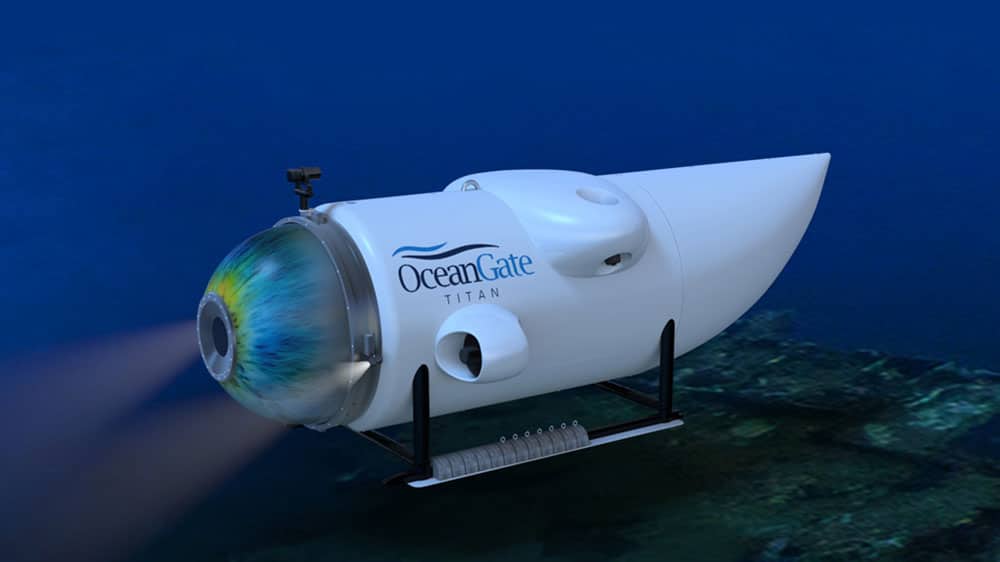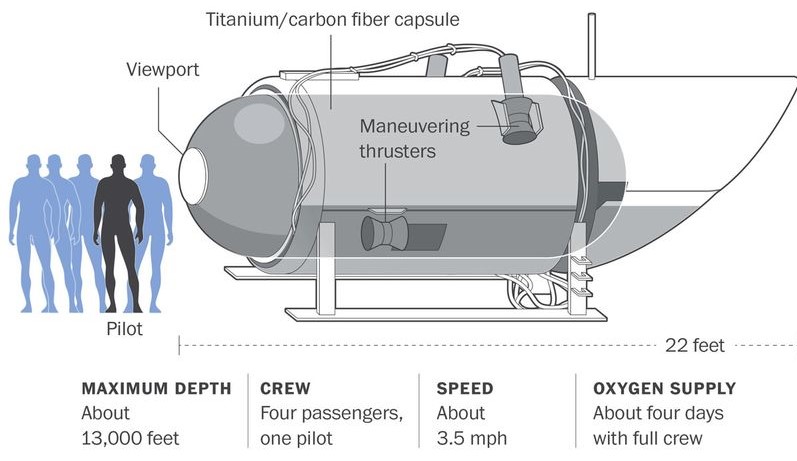In the world of scientific exploration, innovation is king. It’s the driving force that propels humanity into uncharted territories. However, there is a boundary that must not be crossed in the pursuit of groundbreaking advancement.

On June 18th, 2023, a submersible operated by OceanGate known as the Titan went missing in international waters. This was during an expedition to view the wreck of Titanic in the North Atlantic Ocean, off the coast of Newfoundland, Canada. On board the submersible, was OceanGate CEO, Stockton Rush and 4 other individuals. Prior to this time 4 expeditions have been conducted successfully.
One hour and forty-five minutes into the descent, Titan’s mother spacecraft, Polar Prince, lost contact with it. However, due to the estimated three days of oxygen supply, there was a huge, concerted rescue operation by the US coast guard. This rescue operation went on for four days until June 22nd when a remotely operated vehicle discovered a debris field containing parts of the Titan, just half a kilometer away from the bow of the Titanic. This led to the conclusion that the Titan had imploded during the descent resulting in the instantaneous death of all five passengers. The idea of an implosion would later be propped by the US Navy notice of an acoustic signature consistent with an implosion just around the time communication with the submersible was lost.
In the world of scientific exploration, innovation is king. It’s the driving force that propels humanity into uncharted territories. However, there is a boundary that must not be crossed in the pursuit of groundbreaking advancement. There must be a delicate balance between progress and sacrifice. The Implosion of the Titan Submersible is an engineering disaster that should remind engineers never to compromise safety in the quest for innovation.
Oceans Gate and Stockton Rush
Before we can talk about OceanGate or even the Titan, one must first understand the man- Stockton Rush. Stockton Rush had always wanted to be an astronaut, so he started by getting a commercial pilot license. However, because of bad eyesight he could never become a military pilot, hence he proceeded to become a flight test engineer. In 2004, he decided he did not want to go to space anymore. He decided that he wanted something more challenging – deep sea exploration.

Let’s put this into perspective. In science and engineering, deep sea exploration is considered relatively challenging compared to air and space travel. This is primarily due to the engineering challenges required to surmount in building a deep-sea craft. Much of these engineering challenges boils down to pressure. Nobody thinks about air pressure because at sea level it’s just 14.7psf or 1atm and this pressure is as a result of a column of air that extends above us, all the way to outer space. Water, however, is a much denser fluid. For every 10m depth you dive into water, the pressure increases by 1atm. For instance, the Titanic is known to be sitting on the ocean floor at a depth of 4000m, supposing a human being were to be found at this depth, the weight he would feel is equivalent to the weight of the Eiffel Tower.
Founded in 2009, by Stockton Rush and Guillermo Söhnlein, OceanGate is an American tourism and expedition company. Starting from 2010 up until the implosion of the Titan, OceanGate supervised several expeditions, transporting passengers in leased commercial submersibles off the coast of California, the Gulf of Mexico and the Atlantic Ocean. However, Rush soon realized that beyond mere deep-sea expeditions, visiting shipwreck sites were a way to get media attention. In fact, in an interview, Rush said “There’s only one wreck people know….if you ask people to name something underwater it’s going to be Shark’s, Whale’s and Titanic.” So OceanGate decided they were going to build their own submersible.
The Titan
In a bid to acquire their own Submersible, OceanGate started by purchasing Antipodes, a submersible back in 2012. This submersible quickly became the testing bed, for testing and learning about this endeavor. Next, they built Cyclops 1 a deeper sea vessel that could reach a max depth 500m but still couldn’t reach the depth of the Titanic which is at 4000m.
In their final iteration, they arrived at the Titan that was rated for 4000m. The Titan was a 6.7m long, 5 passenger submersible weighing 10,432 kg. Its body is made from carbon fibre and titanium. The complete pressure vessel was made out of a 2.4-meter (7.9-foot) long carbon fibre-wound cylinder with an interior diameter of 142 cm (56 in), and two titanium hemispheres with matching titanium interface rings attached to it. The hatch was provided by a detachable titanium hemispherical end cap that had an acrylic window of 380 mm (15 in) in diameter (Figure 2).

It’s important to state here that the use of Carbon fibre in submersibles is innovation, in fact, carbon fibre is considered exotic in the world of materials. Engineers have been using high strength steel and aluminum in construction of not just submersibles but other works of engineering and there is sufficient engineering data to back up their strength, test methodologies and failure mechanisms. However, carbon fibre is a relatively new engineering material and not much is actually known about it.
Safety Concerns
Before the Titan launched, there were several concerns about the safety of the vessel. The prominent of them all, was by OceanGate Director of Marine, David Lochridge. In January 2018, Lochridge filed a quality control report, citing safety concerns he had about the Titan. In the report he stated that no non-destructive testing/investigation (NDT/NDI) of the carbon fibre whole had taken place to check for voids or delamination that could compromise the whole strength. Bear in mind that NDT/NDI is even a lot more difficult in the world of carbon fibre because it’s a relatively new material, it doesn’t bend, yield, doesn’t grove or contain cracks the way other materials do, testing would require a lot of information and insights.
Instead, Lochridge was told that, OceanGate would rely on the Realtime Acoustic Monitoring System (RTM) which he felt would not provide the crew of potential failure with sufficient time to abort the mission and evacuate. Rightly so, RTM has no way of detecting existing flaws before it’s too late. It only shows when a component is about to fail, often milliseconds before an implosion.
Even worse was the fact that the acrylic window through which passengers view the outside was only certified up to a depth of 1300m – just a third of the depth required to reach the Titanic.
In a meeting Lochridge reiterated that he would refuse to allow crude testing without a whole scan. Lochridge was dismissed from his position as a result and OceanGate would proceed anyway.
In 2020, after series of testing, Rush himself confirmed that the Titan’s hull had being downgraded to 3000m from the initially estimated 4000m. The reason was that the hull was starting to show signs of cyclical fatigue. However, in 2020 and 2021, Rush would confirm that the hull has being rebuilt and re-certified to reach a depth of 4000m. But by whom? More on this shortly.
Previous Incidence
Reporter David Pogue was on board the surface ship in 2022 when Titan went missing and was unable to find Titanic when diving. After the submersible lost communication with its support ship in June 2023, Pogue’s December 2022 article for CBS News Sunday Morning, which questioned Titan’s safety, went viral on social media. “It seems like this submersible has some elements of MacGyver jerry-rigged-ness,” Pogue said to Rush in the report. He said that construction pipes were utilized as ballast and that the submersible was steered and pitched using a $30 Logitech F710 wireless game controller with customized control sticks.
During another 2022 dive to the Titanic, one of the thrusters was inadvertently positioned backwards, causing the submersible to begin spinning in circles as it attempted to advance in the vicinity of the ocean bottom. The solution was to steer by holding the gaming controller sideways, as shown in the BBC documentary Take Me to Titanic. OceanGate stated in court documents dated November 2022 that during a 2022 dive, the submersible experienced battery problems and had to be manually connected to a lifting platform, which resulted in damage to exterior components.
Fastforward, to June 2023 when the Titan Imploded during its fifth mission to the Titanic. It was the first mission of the year in which a dive came close to the Titanic, due to bad weather conditions on previous attempts.
Safety vs Innovation
There is a famous quote by George Santayana, it goes thus: ” those who do not learn from history are doomed to repeat.” While writing this article, this writer cannot help but notice the similarities between the Comet crashes and the implosion of the Titan Sub. The Comet aircraft failures were due to metal fatigue. Similarly, giving that there were four successful expeditions prior to the implosion on the fifth attempt, we can conclude that fatigue is also a culprit in the implosion of the Titan submersible. This is in fact, corroborated in a simulation conducted by Ausin Bansil, a university professor of physics.
However, as with engineering failures, there is always a technical and human component to the failure. While the technical factors that resulted in both failures are similar, the human factors are not. The Comet failures primarily resulted from a failure of imagination – the inability of the Comet engineers to imagine that one stress cycle per flight plane could destroy their planes. The same cannot be said for the Implosion of the Titan. It wasn’t a failure of imagination. Cyclical fatigue was well understood by the design engineers on the Titan. Also, the science and engineering involved was well understood, enough for them to downgrade the Sub during the design stage when it showed signs of cyclical fatigue.
Which raises a strain of very perplexing question: giving the understanding of cyclical fatigue and the fact that the sub was being made out of carbon fiber -a relatively novel material, why will OceanGate refuse an NDI/NDT? why didn’t they seek an independent review for the Titan? why was the Titan not rated or classified by any deep-sea exploration agency?
The answers to these questions are not far-fetched. Firstly, the Titan operated in international waters and because it did not carry passengers from a port, it was not subject to any form of regulation. In fact, a waiver acknowledging that the Titan is an “experimental” vessel “that has not been approved or certified by any regulatory body, and could result in physical injury, disability, emotional trauma, or death” is signed by every passenger. Reporter David Pogue, who completed the expedition in 2022 as part of a CBS News Sunday Morning feature, said this.
Secondly, safety was not a priority design consideration nor is it a part of the core values at OceanGate. Rush was willing to compromise safety for innovation. This explains why when their director of operation, Lockridge sued for a whole scan to be conducted on the Titan, he was dismissed under the grouse that he wasn’t an engineer. Hence, he couldn’t refuse to accept safety approvals from OceanGate’s team. OceanGate said its evaluation of the hull was stronger than any independent certification, Lochridge thought necessary.
If the piece of information above is insufficient to demonstrate OceanGate’s safety culture, Smithsonian magazine called Rush a “daredevil inventor” in a 2019 story. “Needlessly prioritized passenger safety over commercial innovation” is how Rush is quoted in the article in reference to the U.S. Passenger Vessel Safety Act of 1993. Rush stated to CBS News in an interview from 2022 that “safety is just pure waste at some point.” Simply said, stay in bed if you want to be safe. Get out of your automobile. Take no action. In an interview from 2021, Rush stated, “I’ve broken some rules to make Titan.” With sound engineering and reasoning on my side, I believe I’ve shattered them. There is a regulation that says you can’t do it with titanium and carbon fiber. Yes, I did.”
Lessons Learnt
During a press conference to announce Nokia acquisition by Microsoft. Nokia CEO ended his speech by saying “we didn’t do anything wrong but somehow we lost.” Nokia was a respectable telecommunication company, they didn’t do anything wrong, however, the world change so fast, they failed to innovate at the pace of their competitions and so they lost. OceanGate on the other hand changed so fast but did everything wrong. They brought innovation into the deep-sea exploration industry by constructing a submersible that used 5-inch-thick carbon fiber. It was an ambitious and exotic design. However, they compromised on every safety protocol on the altar of innovation, hence they also failed.
Inability to innovate puts you at a risk of losing out even if you do everything right, but innovation without prioritizing safety leads to failure. The implosion of the Titan submersible should serve as a sobering reminder to every engineer, that safety and innovation are mutually inclusive factors in any engineering design. As we continue to explore the frontiers of science and technology, the lessons learned from such incidents must guide our approach. Balancing the thrill of innovation with the steadfast commitment to safety is not only a pragmatic choice but an ethical imperative that will shape the future of exploration and discovery.
Sources & Citation
- Titan submersible implosion. (2023, December 10). Wikipedia. https://en.wikipedia.org/wiki/Titan_submersible_implosion
- Bogel-Burroughs, Nicholas; Gross, Jenny; Betts, Anna (20 June 2023). “OceanGate Was Warned of Potential for ‘Catastrophic’ Problems With Titanic Mission”. The New York Times. Archived from the original on 21 June 2023. Retrieved 10 December 2023
- Kanter, Jake (20 June 2023). “CBS Story On OceanGate’s Missing Titanic Sub Goes Viral After Reporter David Pogue Got Jitters Over Its ‘Jerry-Rigged’ Design”. Deadline. Archived from the original on 28 June 2023. Retrieved 10 December 2023.